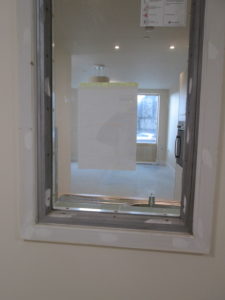Translation of best practice
- Architects and clients work with a range of published guidance for dementia and age friendly design. However, various factors constrain the extent to which this can be implemented.
- Architectural design is shaped and constrained by client requirements and specifications, and some clients (especially larger care providers) have a particular ‘ethos’ or ‘blueprint’ for their buildings. For instance, architects report that some clients like a ‘hotel-like’ aesthetic while others prefer a ‘homely’ aesthetic, and that different clients have different specifications for the size of ‘household’ clusters and staffing ratios. This may or may not align with architects’ knowledge of dementia/age friendly design. The tendency to repeat existing models can limit potential for innovation in rethinking what spaces for later life care might look like.
- Government funding for health and social care is invariably limited and commercial issues can constrain the implementation of principles for best practice in design for later life/dementia.
- Participants in our research report how recommendations for generous space standards or a spare bedroom for relatives in extra care flats can be undermined by wider financial constraints. Government policies such as the ‘bedroom tax’ can mean that older residents are less likely to opt for apartments with two bedrooms.
- There can be clashes between guidance for best practice in design for dementia and later life and other regulations and standards such as building regulations, fire safety legislation and BREEAM*.
- Architects and other participants describe examples of design features being cut or modified because of budgetary constraints and value engineering processes. Gardens and interior design are particularly vulnerable because they happen towards the end of a project.
- Recommendations from guidance for age/dementia friendly design can become lost if they are not included in the brief and tender documents in a clear way, particularly in Design and Build contracts.
*BREEAM is sustainability assessment method, clients and/or planning departments may require building projects to meet a certain standard on this assessment: https://www.breeam.com
Project architect
… the planner wanted particular slates on the roof, we weren’t allowed to use artificial ones. This ate into the client’s budget, there was going to be a proper window in the roof, but the budget wouldn’t allow for it. There were a lot of compromises because of the planning restrictions. In the end the landscaping wasn’t done at all. The landscaping, if done correctly, will draw people out of the building.

